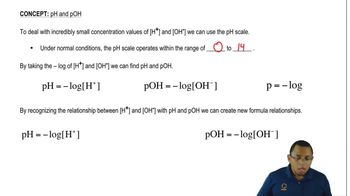One of the most acidic lakes in the United States is Little Echo Pond in the Adirondacks in New York. Recently, this lake had a pH of 4.2, well below the recommended pH of 6.5.
a. What are the [H3O+] and [OH-] of Little Echo Pond?
 Verified step by step guidance
Verified step by step guidance Verified video answer for a similar problem:
Verified video answer for a similar problem:



 1:31m
1:31mMaster The pH Scale Concept 1 with a bite sized video explanation from Jules
Start learning